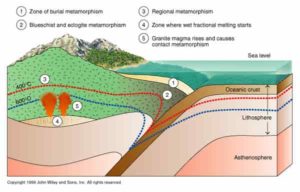
Regional Metamorphism
When rocks are buried deep in the crust, regional metamorphism occurs. This is commonly associated with the boundaries of convergent plate and mountain range formation. Because burial is required from 10 km to 20 km, the affected areas tend to be large.
It happens in a much larger area. This metamorphism creates rocks like gneiss and schist. Large geological processes such as mountain-building cause regional metamorphism. When exposed to the surface, these rocks show the incredible pressure that causes the mountain building process to bend and break the rocks. Regional metamorphism usually produces gneiss and schist-like foliated rocks.
How it formed?
Regional or Barrovian metamorphism covers large areas of continental crust typically associated with mountain ranges, particularly those associated with convergent tectonic plates or the roots of previously eroded mountains. Conditions producing widespread regionally metamorphosed rocks occur during an orogenic event.
The collision of two continental plates or island arcs with continental plates produces the extreme compressive forces needed for regional metamorphic changes. Later, these orogenic mountains are eroded, exposing the intensely deformed rocks characteristic of their core.
The conditions within the subducting slab as it plunges toward the mantle in a subduction zone also produce regional metamorphic effects, characterized by paired metamorphic belts. Structural geology techniques are used to unravel the history of the collision and to determine the forces involved. Regional metamorphism can be described and classified throughout the orogenic terrane into metamorphic facies or metamorphic temperature / pressure zones.










